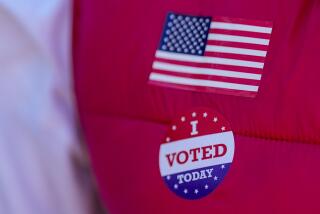Op-Ed: Similarities between Democrats, Republicans make them so different
- Share via
One idea gaining currency among psychologists and political scientists is that Democrats and Republicans are politically polarized because they are fundamentally different. As one science journalist concluded after reviewing the literature: “A large body of political scientists and political psychologists now concur that liberals and conservatives disagree about politics in part because they are different people at the level of personality, psychology and even traits like physiology and genetics.”
Americans are certainly polarized. According to a recent Pew Research Center poll, 36% of Republicans and 27% of Democrats see the opposing party as a threat to the nation’s well-being. But are differences in biology and personality really responsible for political polarization? Perhaps in part. Liberals and conservatives obviously have different ideologies, and research indicates that these ideological differences are correlated with differences in biology and personality.
Research published in Current Biology, for example, found that conservatism was associated with increased gray matter in the right amygdala, whereas liberalism was associated with increased gray matter volume in the anterior cingulate cortex. Other research has found personality differences such that conservatives have a greater need for order, structure and authority than liberals.
But despite the intuitive appeal of such conclusions, explaining political polarization with differences in biology and personality overlooks a crucial fact: A big part of the reason Democrats and Republicans are at loggerheads is that they are so similar.
When Democrats and Republicans in Congress can’t pass legislation — whether on gun control, immigration or climate change — it is often because both sides have dug in with a similar obstinacy. They both think about political information in a partisan, biased manner.
Consider the “party-over-policy” effect, illustrated by Republicans when it came to the Affordable Care Act. The law’s basic tenets — including the idea of an individual mandate — grew out of Republican proposals. But once Democrats got on board, Republicans turned against it, even asserting that the individual mandate was unconstitutional.
The psychological pull to support one’s own party and oppose the other is true of both the left and the right. Geoff Cohen of Stanford University conducted experiments on welfare policy in which subjects felt very differently about proposals depending on which party they were told supported them. “If their party endorsed it,” the study found, “liberals supported even a harsh welfare program, and conservatives supported even a lavish one.” Note the symmetry: Liberal participants were no more likely than conservatives to base their judgments upon the actual content of the policy. Ezra Klein called this kind of party-over-policy thinking the “depressing psychological theory that explains Washington.”
It might seem, therefore, that political differences could be minimized if people could somehow be encouraged to consider policies and evidence in their own right. But this turns out to be not so easy to achieve.
In a recent series of studies on “solution aversion,” Troy Campbell and Aaron Kay of Duke University found that people’s evaluation of scientific evidence was very different depending on whether they saw the policy implications of the science as politically desirable.
Republicans and Democrats read a statement asserting that global temperatures will rise 3.2 degrees in the 21st century. They were then asked to evaluate a proposed policy solution to address the warming. When the policy solution emphasized government regulation (e.g., a tax on carbon admissions), only 22% of Republicans said they believed the temperature projection was accurate. But when the proposed policy solution emphasized the free market, 55% of Republicans accepted the basic science. Liberals exhibited a mirror-image bias when presented with information about crime risk. If a proposed solution threatened liberal ideology, they were more likely to question whether the risk was as severe as described.
Even though they arrive at very different conclusions, liberal Democrats and conservative Republicans process information in fundamentally similar partisan ways. Such biases occur because humans need to belong to social groups, which provide meaning and value to our lives. Seeing other groups as opponents enables us to accentuate the uniqueness and superiority of our own group and to feel better about ourselves. Rejecting information proposed by the opposing side makes us more confident and certain in our political stances.
But being a good group member does not necessarily help relations between groups. The psychological processes that strengthen the bonds of Democrats and Republicans also lead Democrats and Republicans to view the opposing side as fundamentally different — and threatening to the well-being of the country.
So when we see those on the left and right in stark disagreement, we should bear in mind that those disagreements are rooted in fundamental similarities.
David Sherman is a professor of social psychology at UC Santa Barbara. Leaf Van Boven is a professor of social psychology at the University of Colorado Boulder.
Follow the Opinion section on Twitter @latimesopinion
More to Read
A cure for the common opinion
Get thought-provoking perspectives with our weekly newsletter.
You may occasionally receive promotional content from the Los Angeles Times.









